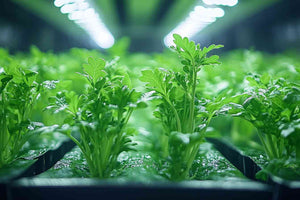Introduction
The full spectrum LED grow light fixtures are the talk of the town among growers. Plants grow under sunlight, so why would you need those LED grow lights to replace nature? The answer is that grow lights become essential in areas where sunlight can’t reach. To be more precise, these lights are a perfect alternative to sunlight in an indoor environment. Therefore, we have full spectrum grow lights available on the market to choose for indoor plants growth. Most growers are still confused about what full spectrum grow light means.
In this article, you will learn everything that you should know about full spectrum grow lights as a grower. It should also help you decide what type of grow light you need for your plantation needs.

What is a Full Spectrum LED Grow Light?
A full spectrum LED grow light is a term that light manufacturers use for marketing their products. It means that a grow light resembles sunlight that plants need for their growth. This term is based on the ‘full-spectrum light’ concept that is in use to describe electromagnetic radiation – infrared to ultraviolet wavebands. In recent years, these lights are rising in popularity for indoor plants, such as cannabis, for their positive impact on plants’ health and growth. If you are an indoor grower and want to create a perfect indoor environment in which plants can grow healthier, LED grow lights are a must.
Full Spectrum Grow Lights in History
The term ‘full spectrum grow light’ is the latest progression of an older term. Originally, this term represents the only full-spectrum source of light, the sun. With time, this term started to get other sunlight characteristics. The lighting industry started using this term for selling their lights that emit a CRI (color-rendering index) over 90. The human eye perceives colors more precisely under sources of light with 90+ CRI. It is very similar to how the human eye sees different colors in the real world under daylight.
It was an advantageous feature for environments, like outdoor spaces and offices. But with the emergence of horticultural lights, companies are now again using this term. Today, the companies claim that a full spectrum LED grow light can reproduce the sunlight effects for plants. Therefore, we now have an array of full-spectrum grow lights that we can use for indoor plantations.
Are There any Problems with a Full Spectrum Grow Light?
There can also be some problems with the full spectrum grow lights concept. For starters, a thing wouldn’t be true just because of its name. This concept may be true for professional lighting designers who want to sell lights to help people see clearly. However, plants need light to live, grow, and feed. Here are the three most common issues with these lights:
1. Not all Full Spectrum Lights Are Optimized for Plantation
The biggest issue with most full-spectrum light fixtures is that these lights have a design to offer an appearance similar to daylight deprived of customization for rigorous growth of plants. You should understand that not all light wavelengths are suitable for photosynthesis. A plant photosynthesizes electromagnetic radiation between 400nm to 700nm, known as PAR (photosynthetically-active-radiation). Therefore, a plant doesn’t care how brighter a light fixture looks.
Still, many full-spectrum lighting manufacturers are designing fixtures this way. A full spectrum light with 5000k+ or 3000k to 4500k diodes means how warm or cool the light will be in appearance. Growers must recognize and improve lighting characteristics that are essential for the growth of specific plants. It means that you must ensure adequate PAR light and the right light spectra mix.
2. They Don’t Include Full-Solar Spectra
Many people believe that a full spectrum LED grow light creates the spectral distribution like sunlight, so the plant will grow better. However, a few theories suggest that it is not like the sun. The radiation of the sun includes greater PAR or visible wavebands. Sunlight contains both infrared and UV light. PAR light plays a vital role in photosynthesis, but plants still react to the PAR spectrum outside radiation. For example, ultraviolet light provokes shielding compounds in the plant just like the way a human becomes tan under the UV presence.
Plants also require far-red light (an infrared light) for inducing the shade avoidance reaction. It makes them stretch and encourages early flowering. Creating a source of light that provokes a plant reaction similar to the sun would prove too costly.
3. They Are Note As Dynamic As the Sun
As we already said, creating a full spectrum grow light would be too costly and if it happens, its performance will still not be accurate enough to reflect the sunlight. The spectrum of the sun is in continuous flux because of changes in its position or weather. The spectra of the sunlight change continuously in various weather conditions that are not yet possible in full spectrum grow lights. Therefore, it is still the best idea to grow plants under direct sunlight. But for indoor plants, you can consider full spectrum LED grow light fixtures.
Using grow light fixtures in greenhouses would still offer you many benefits. You should know that plants don’t require a full spectrum like sunlight. For beginners, plants don’t require infrared or UV light to grow. Plants need 400nm to 700nm light to photosynthesize. Therefore, this is why grow lights are essential for the growth of plants in indoor environments. These lights will help you produce higher yields while improving the quality of plants.

Final Thoughts
The full spectrum lights are not as dynamic as the sunlight and they also don’t include full-solar spectra. However, they can provide 400nm to 700nm light to indoor plants that are sufficient enough for their growth indoors. These lights are the most suitable and closest replacement for the dynamic qualities of sunlight. You can choose from an array of full-spectrum lights according to your plants. They are suitable for commercial and scientific applications where you need precision.
Click here to learn more about full spectrum grow lights.

